INDIAN ARMED FORCES CHIEFS ON
OUR RELENTLESS AND FOCUSED PUBLISHING EFFORTS

SP Guide Publications puts forth a well compiled articulation of issues, pursuits and accomplishments of the Indian Army, over the years

I am confident that SP Guide Publications would continue to inform, inspire and influence.

My compliments to SP Guide Publications for informative and credible reportage on contemporary aerospace issues over the past six decades.
SPEICAL REPORT
Flawless First Flight
India’s aerospace industry crossed a significant milestone in its march towards self-reliance when the first prototype of the five tonne class LCH, designed and developed by HAL, was unveiled

“It is a red-letter day for not only the Hindustan Aeronautics Limited (HAL), but the whole nation. I am quite positive that the aircraft will meet all the Indian Air Force (IAF) requirements in this class of helicopters. The first flight has been superb,” said an enthused Air Marshal P.K. Barbora, the IAF’s Vice Chief of Air Staff after witnessing the maiden official flight of the indigenous light combat helicopter (LCH) on May 23, at HAL’s Bengaluru airport.
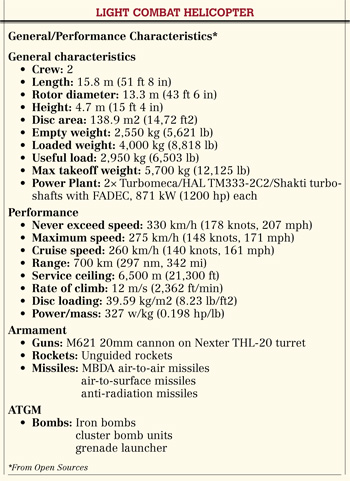
It seemed a good effort by HAL to indigenously design, develop and test fly the LCH since the project began in full earnest in 2006 at a projected cost of 376 crore ($80 million). The idea of a light combat helicopter was conceptualised way back in 1989 by HAL based on an IAF requirement. However, it was just as well that the government clearance came only in 2006 by when HAL’s advanced light helicopter (ALH) Dhruv had not only reached full maturity, but had also been inducted for operational service. The earlier design which had debuted in 2001 at the Paris Air Show as the light attack helicopter (LAH) was heavily restyled into what came to be known as the LCH. A derivative of Dhruv, the original slimmed-down “gunship” fuselage was discarded and basic Dhruv airframe was retained except for forward fuselage which was modified to tandem crew seating. The LCH incorporates several features of the HAL built ALH Dhruv, which includes the hinge-less rotor, transmission system, Shakti engines, hydraulics, full glass cockpit, integrated defensive aids suite (IDAS) and weapons systems.
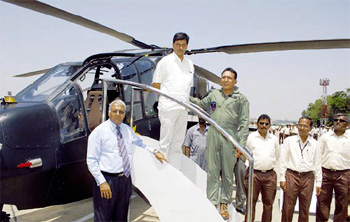
Developed for dedicated combat role, the unique features that provide agility, survivability and lethality to the LCH are its narrow fuselage for low drag profile, armour protection of critical areas, crashworthy landing gear with a tail wheel, crashworthy and self-sealing fuel tanks, aerofoil shaped stub wings for weapons, electronic warfare suite, self-protection suite (SPS) consisting of radar/laser missile warning systems and counter-measures dispensing system (CMDS), armour and NBC protection as also stealth features. It is also planned to integrate IR/laser missile jammer on the helicopter. The gear box has the capability of running for 30 minutes even after total loss of oil in case of a ballistic damage to the transmission system. Dual redundant systems also enhance survivability in a battlefield environment.
When fully developed, the armament suite of the LCH will comprise a 20 mm turret gun in the nose slaved to the helmet mounted sights of the pilot and the flight gunner. The LCH will also carry rocket pods, air defence missiles and air-to-surface missiles on the weapon stations under the stub wings. It will be equipped with “target acquisition and designation system” providing day/night targeting capability through electro-optical pod consisting of CCD camera, FLIR, laser range finder and laser designator. A digital video recorder would enable recording of the entire mission for post-mission debrief. Equipped with data link that would facilitate transfer of the mission data to the other airborne platforms and ground station, the helicopter would be capable of operating in a network-centric environment (see box for general/performance characteristics).
VIEW POINT
Air Chief Marshal (Retd) S.P. Tyagi
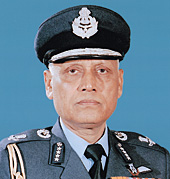
India had attack helicopters but they were heavy ones. We needed helicopters that can operate in hilly areas. We had two choices either look for one in the global market or weaponise the ALH. Besides the Kargil War, internal disturbances also kept mounting and so the need to develop a light combat helicopter became all the more necessary. It is being reported that the helicopter is slightly heavy, but I believe technology will make it lighter in days to come. All in all, it is a positive and highly welcome step towards self-reliance.
VIEW POINT
Air Chief Marshal (Retd) F.H. Major
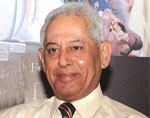
I was present for the LCH dedication ceremony at Bengaluru on May 23, 2010 and the flying display by this versatile attack helicopter was simply outstanding. I think the LCH has great potential—the agility, a potent weapons mix, state-of-the-art target designation/weapons-aiming suite & a crash-worthy design of the LCH are path-breaking features. Having said this, I must emphasise the point that the LCH still has many milestones to achieve before the FOC (full operational clearance) stage. The most important ones being the integration of onboard weapons/sensors followed by weapon-release/firing trials, certification/integration of the Shakti engine and a series of trials in different terrain/weather conditions. Notwithstanding the fact that the LCH is a derivative of the Dhruv (ALH), the sleek tandem-seat design gives it a distinctive lean, mean and venomous look – that’s how an attack helicopter should look like, when seen by an adversary.
The performance of the LCH i.e. rate of climb, cruise speed, service ceiling, etc, are on a par and on some scores even better than other helicopters in its class like AW129 Mangusta or the Eurocopter Tiger, the helicopters it has great resemblance with. It may be recalled that for the eventual and inevitable phasing out of its ageing fleet of Mi-25/Mi-35 attack helicopters, the IAF had issued a RFP for the acquisition of 22 attack helicopters worth over $500 million (2,315 crore) in May 2008 to leading global manufacturers which included US Bell (AH-1Z Cobra) and Boeing (AH- 64 Apache), British-Italian AgustaWestland (AW129 Mangusta), EADS Eurocopter (Tiger), Russian Mil (Mi-28) and Kamov (Ka-50/52). The RFP had later fallen through for a multitude of reasons with the responsibility for the same on the shoulders of many players. The RFP has since been reissued hoping for full participation from everyone. However, the above is a short-term project for the replacement of the existing fleets in the IAF. The LCH programme would cater to the long-term, larger needs of both the IAF and the Indian Army. A table to compare major attributes of the competing helicopters in the above mentioned RFP and that of the LCH has been given in the article.
LCH Unveiled
India’s aerospace industry crossed a significant milestone in its march towards self-reliance when the first prototype of the five tonne class LCH, designed and developed by the Hindustan Aeronautics Ltd (HAL), was unveiled at Bengaluru on May 23, 2010. Wing Commander Unni Pillai, the Chief Test Pilot of HAL, duly assisted by the co-pilot Group Captain Hari Nair, staged an impressive 20 minute aerial demonstration of this new highly manoeuverable and versatile machine. The profile included the reverse slide which perhaps is one of the most difficult and tricky manoeuvres to perform.
The event was witnessed by Air Marshal P.K. Barbora, Vice Chief of Air Staff who was the Chief Guest, R.K. Singh, Secretary, Defence Production, several senior functionaries from the armed forces and the defence industries and research establishments. On account of the gruesome air tragedy at Mangalore the previous day which resulted in heavy loss of life, Defence Minister A.K. Antony, Minister of State for Defence Pallam Raju, and Chief of the Air Staff Air Chief Marshal P.V. Naik were unable to attend the ceremony. Dedicating the LCH to the nation, Air Marshal Barbora complimented the HAL for the successful design and development of the machine which he described as “no mean achievement”. He stated that the LCH is “badly needed” by the Indian Air Force and hoped that the machine would be ready to enter service in two-three years. He hoped that the overweight problem which is commonly encountered in the development of new aircraft would be corrected in due course before its operational induction into the IAF.
Addressing the gathering, R.K. Singh said that the LCH was a “truly fine” machine and that the indigenous development of the helicopter was important for both strategic and economic considerations. He was hopeful that the LCH would receive initial operational clearance (IOC) by the end of 2010 and final operational clearance (FOC) soon after. He stressed the vital need for India to achieve high levels of self-reliance in the regime of defence production as also in respect of research and development capabilities.
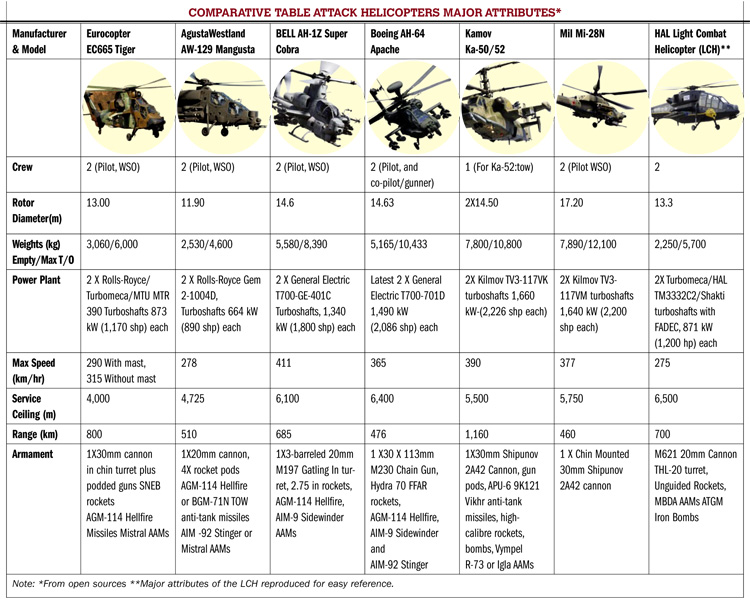
If the flight-testing which would involve more than 500 flights, progresses without any major glitches, the initial operational clearance (IOC) could be achieved by 2013 with an inservice induction by 2014. When operationalised, the LCH will give air-warriors the capability to engage targets at high altitudes, up to and even above 5,000 m, lack of which was sorely felt during the 1999 Kargil operations. During the unveiling ceremony on May 23, Ashok Nayak, Chairman, HAL, had revealed that the defence PSU already had a firm order from the IAF for 65 LCHs. The Indian Army has also evinced interest and in the long run could go in for 100-plus machines.
Finally, while it may be true that most of the helicopter’s sub-systems such as avionics packages and weapons may be imported, the indigenous design and systems integration could still peg the LCH as one of the most competitive and cost-effective products in its class worldwide. Another much needed success story for the Indian aerospace industry.





